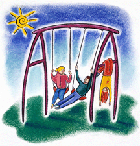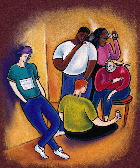Tips for Raising Safe and Healthy Kids
Click on the
links below to learn more about raising safe and healthy kids.
PDF
 | En Español
| En Español

 Plan
a Healthy Pregnancy Plan
a Healthy Pregnancy
http://www.cdc.gov/ncbddd/bd/abc.htm
Give your child a good start by planning a healthy pregnancy. Women should
take folic acid before getting pregnant and avoid drinking alcohol during
pregnancy to prevent several birth defects.
Know your family and medical history to determine if you or the baby are at
increased risk for certain diseases and conditions. Also see
related links on this page.
 Keep
Their Check-Ups and Immunizations Up-to-Date Keep
Their Check-Ups and Immunizations Up-to-Date
http://www.cdc.gov/nip/publications/Parents-Guide/
Routine exams and screenings help you and your kids prevent, identify, and
treat health problems when they arise. Vaccines help prevent infectious
diseases and save lives. Also see related links on
this page.
 Protect
Your Kids Protect
Your Kids
http://www.cdc.gov/ncipc/cmprfact.htm
Although kids are small, they are quick, curious, and not aware of dangers.
Take steps to make sure your home, vehicle, play areas, day care, schools,
and other environments are safe for your kids. Use car seats and seat belts.
Supervise your kids and make them aware of hazardous substances and
situations. Also see related links
on this page.
 Provide
Healthy Meals Provide
Healthy Meals
http://www.cdc.gov/nccdphp/dnpa/tips/
healthy_children.htm
Eating right will help provide the nutrients needed to have energy, build
strong bones, and fight diseases and other conditions. Pay attention to what
and how much your kids eat. This could help indicate problems of which you may
not be aware. Also see related links on this page.
 Keep
Them Active Keep
Them Active
http://www.cdc.gov/nccdphp/dnpa/physical/
recommendations/young.htm
Regular physical activity in childhood and adolescence improves strength and
endurance, helps build healthy bones and muscles, helps control weight,
reduces anxiety and stress, increases self esteem, and may improve blood
pressure and cholesterol levels. Also see related links
on this page.
 Live
a Smoke-Free Life Live
a Smoke-Free Life
http://www.cdc.gov/tobacco/how2quit.htm
Being exposed to second-hand smoke is just as unhealthy as smoking directly.
Women should be smoke-free during pregnancy to prevent premature birth and
other health problems. Stay smoke-free to help reduce your children's risk
for sudden infant death syndrome (SIDS), bronchitis, asthma, and pneumonia.
Also see related links on this page.
 Monitor
Their Activities Monitor
Their Activities
http://www.ed.gov/parents/academic/help/
hyc.html?exp=0 (Non-CDC site)
Kids learn from family, friends, television, music, video games, the
internet, and more. These influences help to shape their view of the world,
how they interact, and what they learn. Know what they are listening to and
watching, how much time they spend with an activity, and if it’s appropriate
for their age. Ask yourself if there are healthy and fun activities they
(and you) can do, and start today.
 Teach
Them Healthy Habits Teach
Them Healthy Habits
http://www.cdc.gov/germstopper/
Provide your kids with a good foundation to help them make healthy choices
every day. Seat belts, helmets, sunscreen, tooth brushing, and hand washing
are just a few of the things that help to keep us all safe and healthy. Make
good health choices a part of your daily life to show kids how to do it.
 Talk
to and Listen to Your Kids Talk
to and Listen to Your Kids
http://www.cdc.gov/nasd/docs/d001201-d001300/d001278/d001278.html
Health starts at home. Talking to your kids may help them better understand
how they can be healthy, safe, and happy. Find out what’s going on with
them, how they are making decisions and handling problems, and what
questions they have about life. There are plenty of resources available if
you need to get some answers first. Also see related links
on this page.
 Provide
Love and Support Provide
Love and Support
http://www.family.samhsa.gov/ (Non-CDC site)
Kids need the support and love of family and friends. Times of stress
or emergency may make kids vulnerable to health and psychological problems.
Determine if stress related to school, body changes, thoughts and feelings,
family issues, death of loved ones, or changes in general are causing
problems. Help your kids make connections and have balance in their lives.
Also see related links on this page.

Related Links
LINKS
ON THIS PAGE
Plan a Healthy Pregnancy
Keep Their Check-Ups and Immunizations Up-to-Date
Protect Your Kids
Provide Healthy Meals
Keep Them Active
Live a Smoke-Free Life
Talk to and Listen to Your Kids
Provide Love and Support
Plan a Healthy Pregnancy
Guidelines for
Vaccinating Pregnant Women
http://www.cdc.gov/nip/publications/preg_guide.htm
Safe Motherhood:
Promoting Health for Women Before, During, and After Pregnancy
http://www.cdc.gov/nccdphp/aag/aag_drh.htm
Taking Folic Acid
http://www.cdc.gov/node.do?id=0900f3ec80010af9

Keep Their Check-Ups and Immunizations Up-to-Date
The
Importance of Childhood Immunizations
http://www.cdc.gov/nip/publications/fs/gen/importance.htm

Protect Your Kids
Ideas for a
Healthier, Safer Summer
http://www.cdc.gov/od/oc/media/presskits/summer.htm
Protective Eyewear for Young Athletes
http://www.guideline.gov/summary/summary.aspx?
doc_id=4861&nbr=3502&ss=6&xl=999
Summer Safety
Tips- American Academy of Pediatrics
http://www.aap.org/advocacy/releases/summertips.htm (Non-CDC site)

Provide Healthy Meals
5 A Day Tips:
5 A Day With 5 Kids A Day
http://www.cdc.gov/nccdphp/dnpa/5ADay/tips/kids.htm

Keep Them Active
Adolescents and Young
Adults
http://www.cdc.gov/nccdphp/sgr/adoles.htm
Can I Get HIV While
Playing Sports?
http://www.cdc.gov/hiv/pubs/faq/faq30.htm
CDC
Sports Initiatives
http://www.cdc.gov/tobacco/sports_initiatives_splash.htm
Energize Your Life
http://www.cdc.gov/nccdphp/dnpa/physical/
Healthier US
http://www.healthierus.gov/ (Non-CDC site)
How
Parents Can Encourage Girls to Play Sports
http://www.cdc.gov/tobacco/sport_initiatives/daugthertips.htm
Nonfatal
Sports- and Recreation-Related Injuries Treated in Emergency Departments ---
United States, July 2000--June 2001
http://www.cdc.gov/mmwr/preview/mmwrhtml/mm5133a2.htm
Physical Activity: Promoting Better Health
http://www.cdc.gov/HealthyYouth/physicalactivity/promoting_health/
strategies/families.htm
Promoting
Oral Health: Interventions for Preventing Dental Caries, Oral and Pharyngeal
Cancers, and Sports-Related Craniofacial Injuries
http://www.cdc.gov/mmwr/preview/mmwrhtml/rr5021a1.htm
Preventing Injuries in Sports, Recreation, and Exercise
http://www.cdc.gov/ncipc/pub-res/research_agenda/05_sports.htm
Sports Stars and
Coaches Support Tobacco-Free Sports for Youth
http://www.cdc.gov/nccdphp/cdnr/cdnr_fall0106.htm
Youth Sports and Recreation Programs
http://www.cdc.gov/HealthyYouth/PhysicalActivity/promoting_health/
strategies/sportrec.htm

Live a Smoke-Free Life
Facts
on Sports and Smoke-free Youth
http://www.cdc.gov/tobacco/research_data/youth/ythsprt1.htm
Keeping Your Kids Tobacco, Alcohol, and Drug Free
http://www.cdc.gov/tobacco/educational_materials/mykdhigh.htm
Second-hand Smoke
http://www.cdc.gov/tobacco/factsheets/secondhand_smoke_factsheet.htm
Smoking Harms Reproduction
http://www.cdc.gov/tobacco/sgr/sgr_2004/consumerpiece/page5.htm
You(th) and Tobacco
http://www.cdc.gov/tobacco/educational_materials/yuthfax1.htm

Talk to and Listen to Your Kids
Family Adolescent Risk
Behavior and Communication Study
http://www.cdc.gov/nchstp/od/news/adol.htm

Provide Love and Support
Bioterriorism

http://www.bt.cdc.gov/children/pdf/working/execsumm03.pdf
Diabetes:
Resources on Children and Adolescents
http://www.ndep.nih.gov/diabetes/youth/youth.htm (Non-CDC site)
Disease Support
Groups
http://www.cdc.gov/genomics/links/support.htm

 This site contains documents in PDF format. You will need Adobe Acrobat Reader
to access the file. If you do not have the Acrobat Reader, you may download a
free copy from the
Adobe Web site.
This site contains documents in PDF format. You will need Adobe Acrobat Reader
to access the file. If you do not have the Acrobat Reader, you may download a
free copy from the
Adobe Web site.
Home |
Privacy Policy |
Accessibility | Disclaimer
CDC Home |
Search |
Health Topics A-Z
This
page last reviewed September 30, 2004
URL: http://www.cdc.gov/od/spotlight/nwhw/g-tips.htm
United States Department of Health and Human
Services
Centers for Disease Control and Prevention
Office of the Director
Office of Women's Health |


